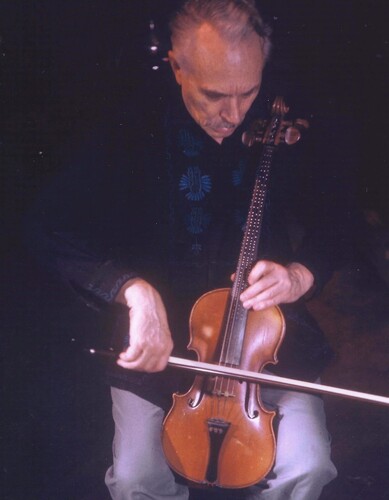First Experiments
Harry Partch's Early Period
In the early stages of Harry Partch's musical evolution, the concept of “monophony” – his approach to the use of just intonation (the practice of tuning musical intervals as exact whole number ratios of frequencies) – was central to his musical aesthetic. One of Harry Partch’s seminal creations during his early period was the adapted viola, a transformative instrument that was the first physical realization of his musical philosophy. In pieces such as Two Psalms for voice and adapted viola, Partch began to explore the realms of just intonation and non-conventional scales.
In 1930, during a trip to New Orleans, Partch finalized the aforementioned adapted viola, a process that involved affixing a cello fingerboard to a viola. This modification allowed him to achieve the precise microtonal pitches he envisioned for his compositions. Through the precise placement of brads and lines, he indicated the appropriate finger positions on the instrument for playing in a scale built on a 29-note division of the octave. This adapted viola would go on to serve as a vehicle for his exploration of new harmonic territories.
 Harry Partch playing his adapted viola
Harry Partch playing his adapted viola
Partch's compositional output during this period, exemplified by works such as Two Psalms from 1931, exemplifies his early musical philosophy. Two Psalms is a so-called "monophonic" piece for voice and adapted viola; the Biblical psalms set are “The Lord is My Shepherd” and “By The Rivers of Babylon.” Partch explained this unique musical philosophy in an early theoretical treatise, "Exposition of Monophony," which he began drafting in 1928. In this work, Partch extended triadic consonance to include the 7th, 9th, and 11th partials, pushing the boundaries of traditional harmonic structures.
Harry Partch performing "The Lord is My Shepherd" from Two Psalms (1931)
In other monophonic pieces, Partch set texts by literary figures such as Li Po (a Chinese poet) and Shakespeare; all feature an intoning voice performing in Sprechgesang, or speech-song. Partch acknowledged such diverse influences as Gluck, Mussorgsky, Debussy, and Mahler in his approach to text setting, in that the musical rhythm of the text is determined by the inherent or natural rhythms of the spoken word. However, Partch went further than previous composers when it came to replicating the pitches of speech in a piece of music. In a Los Angeles times article from 1932, Partch acknowledged a “simulation of speech” in Schönberg’s Pierrot Lunaire, but qualifies that by noting that Schönberg’s work lies within the “wide-spaced twelve-tone tempered scale,” suggesting that his use of such fine divisions of the octave was motivated by a desire to more closely match the microtonal pitches of the spoken word on an instrument.
Lou Harrison's Early Period
While Partch’s early period centered around works featuring the human voice, Lou Harrison's early musical philosophy was largely defined by his incorporation of non-traditional and non-Western musical instruments into his compositions for percussion. After graduating from college, Harrison collaborated with choreographers in San Francisco during the late 1930s and taught a class on writing music to accompany dance. His collaborations with dancers, including Bonnie Bird, Carol Beals, and Lester Horton, provided him with a unique perspective on rhythm and motion in music.
Significantly, in 1938, he came to know John Cage, resulting in several jointly staged percussion concerts and even a collaboratively-composed piece in 1941 titled "Double Music" for four percussionists. In this piece and many others from this time period, including the Canticles nos. 1 and 3 and Song of Queztalcóatl, Harrison incorporated "found" instruments such as brake drums, flowerpots, and metal pipes into the ensemble. Additionally, Harrison's interest in diverse cultural traditions led him to integrate instruments from other cultures, such as the clay ocarina and the teponaztli, a wooden slit-drum from Mexico, into his works.
 Lou Harrison, c. early 1940s
Lou Harrison, c. early 1940s
In 1942, Harrison composed his "Suite for Percussion." In this work, Harrison expanded the traditional battery of percussion instruments to include a variety of sounds from various cultures and sources, including brake drums, temple blocks, a thunder sheet, and a washtub. The Suite showcased Harrison's interest in blending diverse timbres and polyrhythms, a preoccupation that would resurface and combine with his interest in Gamelan music later in his career.
Suite for Percussion (1942)
Table of Contents
- Website Overview
- Background
- First Experiments || You Are Here!
- Developing Styles
- Mature Incarnations
- Legacies & Impact
- Bibliography